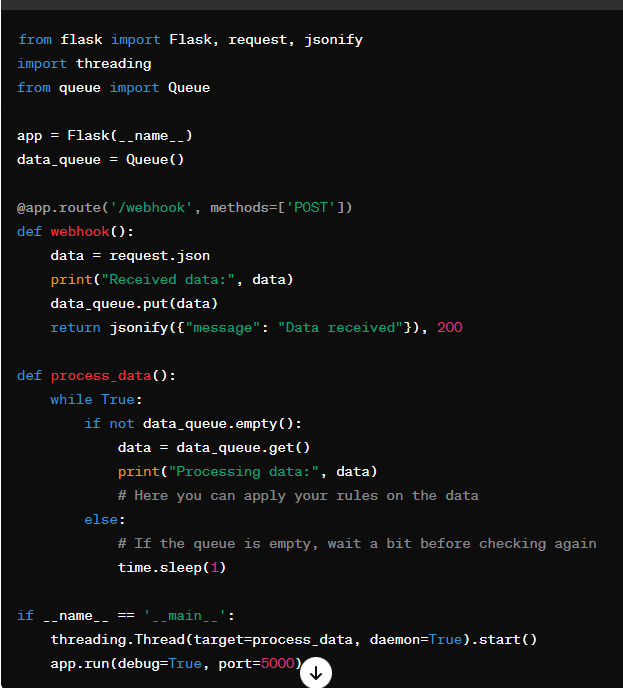Webhooks and Multithreading in Python Applications
Efficiently Process Real-Time Data with Flask, Queues, and Daemon Threads
What is a Webhook?
Imagine a scenario where your application needs to react instantly to events from another service, like receiving notifications of transaction status changes from a payment gateway.
Webhooks are the bridge that makes this real-time communication possible. Unlike traditional APIs that require frequent polling to retrieve new data, webhooks send data to your application as events occur, making the data exchange process more efficient for both the provider and the consumer.
Example Scenario
Let's say you're building a system that listens for events from a third-party service (e.g., a payment gateway notifying you about transaction status changes).
The payment gateway will send (HTTP POST) a JSON payload to a URL you've configured every time there's a new transaction event.
Step 1: Setting the Stage with Flask
To start listening for webhook events, you'll need an endpoint in your application. Using Flask, a lightweight Python web framework, you can easily set up this endpoint. Flask's simplicity and flexibility make it a great choice for both beginners and seasoned developers.
Installation
Make sure Flask is installed:
pip install flaskConcepts:
1. Multithreading Magic
To handle incoming data without blocking or slowing down your Flask application, we employ Python's threading module to process data in the background. By creating a daemon thread dedicated to data processing, we ensure that our application remains responsive and can gracefully shut down, as daemon threads are automatically terminated when the main program exits.
2. Implementing a Thread-Safe Queue
The use of a thread-safe queue, like Python's Queue, is pivotal in our architecture. It serves as a safe conduit for passing data between the main Flask thread and our background processing thread. This setup guarantees that our data integrity is maintained, even when multiple threads access and modify the queue simultaneously.
Application Code
Create a new Python file, let's call it app.py:

Step 2: Understanding the Code
Flask App Setup: A simple Flask app is initialized, and a route
/webhookis defined to listen for POST requests. This endpoint is where the third-party service will send its JSON payload.Queue for Data Processing:
A thread-safe queue (
data_queue) is used to hold incoming data. This allows your webhook endpoint to quickly respond to incoming requests without having to wait for data processing to complete.Background Thread for Data Processing: A background thread runs the
process_datafunction, which continuously checks the queue for new data. When new data is found, it is "processed". Here, processing is simulated by printing the data, but this is where you could apply rules or perform actions based on the data content.Daemon Thread: The background thread is marked as a daemon, meaning it will automatically stop when the main Flask application stops. This is important for preventing the application from hanging on shutdown.
Running the Flask Application: The Flask app runs on port 5000 and listens for incoming webhook events. The background thread starts before the Flask app and runs
process_datain the background.
How to Test It
To test this setup, you'll need to send a POST request to http://localhost:5000/webhook with a JSON payload. You can use tools like Postman or curl for this:
curl -X POST http://localhost:5000/webhook -H "Content-Type: application/json" -d '{"event": "transaction_completed", "amount": 100}'When you send this request, the Flask application should receive the data, enqueue it, and the background thread should print the received data, simulating its processing.
Daemon thread in Python
The Python code snippet threading.Thread(target=process_data, daemon=True).start() is used to create and start a daemon thread in Python that executes a function called process_data. Let's break down what each part of this line of code does:
threading.Thread()
Purpose: This constructs a new thread object.
Module:
threadingis a built-in Python module that provides a way to create, manage, and synchronize threads.Usage:
Thread()is a constructor of theThreadclass in thethreadingmodule.
target=process_data
Purpose: Specifies the function that the thread will run.
Explanation: The
targetargument is used to pass the function object that the thread should execute. In this case,process_datais the name of the function that will be run by the thread. Note that you pass the function without parentheses (()), meaning you're passing the function itself, not calling it.
daemon=True
Purpose: Sets the thread as a daemon thread.
Explanation: A daemon thread runs without blocking the main program from exiting. When the main program exits, all daemon threads are terminated abruptly. Setting
daemon=Trueis useful for background tasks that should not keep the program running if the main thread finishes. In contrast, non-daemon (or "user") threads can keep the application running until they complete their task.
.start()
Purpose: Starts the thread.
Explanation: Once a thread object has been created, calling its
start()method causes the thread to run. The thread will then execute the target function in parallel to the main program. This allows for concurrent execution within the program.
NOTE:
Choosing to use
Queuein the context of background threading:
Choosing to use data_queue.put(data) in the context of background threading is a strategic decision for handling concurrency in your application, especially when dealing with shared data between threads. Here's why it's an effective choice:
Thread Safety
Queues in Python, especially those from the queue module (like Queue), are designed to be thread-safe. This means they correctly handle multiple threads accessing and modifying the queue simultaneously without causing data corruption or other concurrency issues. Using a thread-safe mechanism is crucial in a multithreaded environment to ensure data integrity.
Communication Between Threads
Using a queue provides a straightforward way to communicate between threads in your application.
The main thread (handling web requests) places incoming data into the queue with data_queue.put(data). The background thread then retrieves this data using data_queue.get(), processes it, and can act upon it accordingly.
This decouples the receiving of data from its processing, allowing each part to operate independently at its own pace.


♥♥♥♥